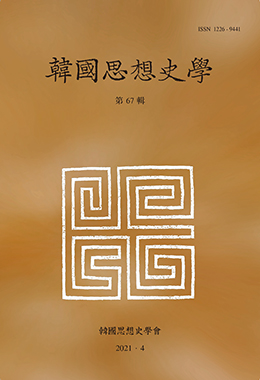본고는 『왕오천축국전』의 저자로 알려진 혜초의 또 다른 면모인 밀교승려로서의 성격을 검토하였다. 이를 위해 혜초가 밀교경전인 『대승유가 금강성해만수실리천비천발대교왕경(大乘瑜伽金剛性海曼殊室利千臂千鉢大教王經)』(이하 『천발경』)의 서문을 남긴 점에 주목하여, 서문의 내용을 바탕으로 『천발경』의 사상적 특징을 알아봄으로써, 혜초의 밀교 승려로서의 행적과 사상 경향을 파악하였다. 나아가 혜초의 활동과 사상경향이 신라 불교계에 영향을 미쳤을 가능성을 제시하였다.
『천발경』 서문에 따르면 혜초는 이 경의 한역 과정에 참여 하였으며, 이후에도 『천발경』에 대한 탐구를 지속하면서 금강지와 불공으로부터 가르침을 받았다. 혜초는 이 시기 불공의 제자로 손꼽히고 내도량 사문이자 지송승으로 활약하였기에 그의 당에서의 위상은 높았다고 파악된다.
혜초는 밀교 승려로서 활동하면서 오랜 시간동안 『천발경』의 의미를 파악하는데 노력하여, 서문을 통해 경의 구성과 사상의 요지에 대한 자신의 입장을 적었다. 이 경은 비로자나·아촉·보생·관자재왕·불공성취 등 다섯 부처의 관법에 따라 5문체제로 구성되어 있는데, 천비천발문수 보살의 오자진언을 다섯 부처와 지혜에 대비하였다. 천비천발문수는 이경의 주 설법자로서 금강삼마지의 성취를 강조한다. 이처럼 이 경은 금강계 밀교로의 이행기적 특징을 바탕으로 천비천발문수신앙을 담고 있다. 금강계 밀교에서 말하는 교리는 오방불 도상의 성립에 영향을 미쳤고, 혜초의 스승 불공은 문수신앙을 매개로 오대산 신앙을 확산시켰다.
이와 같은 혜초의 행적의 동향과 사상적 경향은 신라에 오대산 신앙이 전파되고, 금강계 밀교가 전래되어 오방불이 제작되는 과정에 자연스럽게 직·간접적으로 영향을 미쳤을 가능성이 있음을 보여준다.
This study examined Hyecho(慧超)'s characteristics as a Esoteric Buddhist monk, a different side of him, who is known as the author of the Wangocheon Chukgukjeon(往五天竺國傳).
For this, this study paid attention to the fact that Hyecho wrote the preface of Dacheng Yuja Manshushili Qianbeiqianbo DajiaowangJing sutra(大乘瑜伽曼殊室利千臂千鉢大敎王經). So this study analyzed Hyecho's activities, ideological trends, and the ideological characteristics of scriptures by examining the preface. Furthermore, it suggested that Hyecho's activities and ideological trends influenced the Buddhist community of Silla.
According to the preface, Hyecho participated in the translation process of Dacheng Yuja Manshushili Qianbeiqianbo DajiaowangJing sutra, continued to study the scriptures, and received scripture-related instruction from Vajrabodhi(金剛智) and Amogha-vajra(不空). Hyecho was one of the greatest disciples of Amogha-vajra and was involved in activities related to the Tang Dynasty's imperial family, so it is believed that his status in the Tang Dynasty was high.
Hyecho spent a long time trying to understand the meaning of the this sutra, and wrote down his position on the scriptures through the preface. This sutura exhibits the transitional characteristics of the Vajra-yana Esoteric Buddhism, and contains faith of the Thousandarmed Thousand bowl Mañjuśrī. The Vajra-yana Esoteric Buddhism dogma influenced the establishment of Five-directional Buddhas, and Hyecho's teacher Amogha-vajra spread the faith of Mount Odae cult throughout the country based on befief of Mañjuśrī.
Therefore, it is highly likely that Hyecho's activities and ideas influenced the spread of Mount Odae cult in Silla, and the introduction of the Vajra-yana Esoteric Buddhism, which led to the production of five-directional Buddhas.




